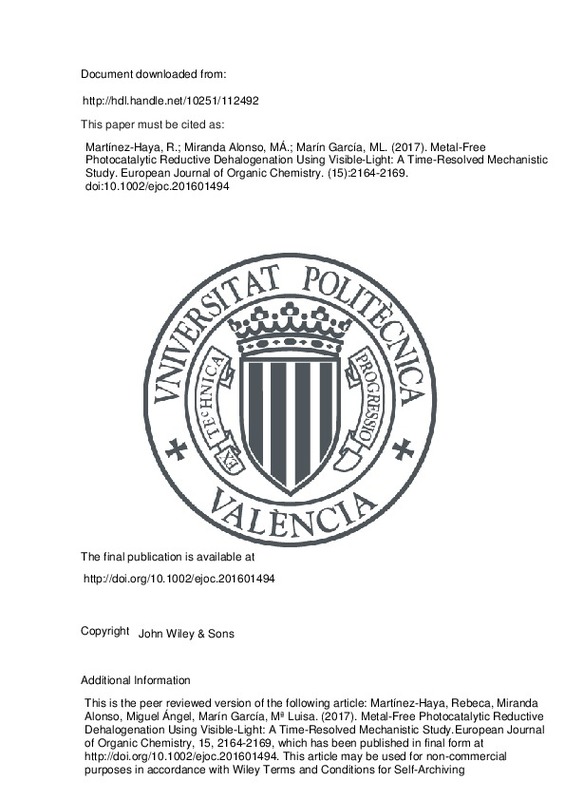JavaScript is disabled for your browser. Some features of this site may not work without it.
Buscar en RiuNet
Listar
Mi cuenta
Estadísticas
Ayuda RiuNet
Admin. UPV
Metal-Free Photocatalytic Reductive Dehalogenation Using Visible-Light: A Time-Resolved Mechanistic Study
Mostrar el registro sencillo del ítem
Ficheros en el ítem
| dc.contributor.author | Martínez-Haya, Rebeca
|
es_ES |
| dc.contributor.author | Miranda Alonso, Miguel Ángel
|
es_ES |
| dc.contributor.author | Marín García, Mª Luisa
|
es_ES |
| dc.date.accessioned | 2018-11-14T21:02:09Z | |
| dc.date.available | 2018-11-14T21:02:09Z | |
| dc.date.issued | 2017 | es_ES |
| dc.identifier.issn | 1434-193X | es_ES |
| dc.identifier.uri | http://hdl.handle.net/10251/112492 | |
| dc.description | This is the peer reviewed version of the following article: Martínez-Haya, Rebeca, Miranda Alonso, Miguel Ángel, Marín García, Mª Luisa. (2017). Metal-Free Photocatalytic Reductive Dehalogenation Using Visible-Light: A Time-Resolved Mechanistic Study.European Journal of Organic Chemistry, 15, 2164-2169, which has been published in final form at http://doi.org/10.1002/ejoc.201601494. This article may be used for non-commercial purposes in accordance with Wiley Terms and Conditions for Self-Archiving | |
| dc.description.abstract | [EN] The reductive dehalogenation of organic bromides has been achieved in the presence of riboflavin (RF) as photocatalyst under visible-light irradiation. Specifically, benzyl bromide (2) and -bromoacetophenone (3) were quantitatively converted into toluene and acetophenone, respectively, by using amines as electron donors and iPrOH as hydrogen donor, whereas bromobenzene (1) did not react. The thermodynamics of the reduction of the radical anion of RF were evaluated by using the redox potentials of the species involved: The reaction was found to be thermodynamically exergonic for 2 and 3, but not expected to occur for bromobenzene (1). The viability of the different competing processes on the timescales of the corresponding singlet and triplet RF excited states ((RF)-R-1* and (RF)-R-3*) was analyzed by time-resolved techniques. The quenching of (RF)-R-1* by amines was very efficient, and comparison of the transient absorption spectra recorded in the absence and presence of amines additionally confirmed the efficient redox process between (RF)-R-1* and the amines. Moreover, RF- was quenched by bromides 2 and 3, but not by 1. Thus, a deeper understanding of the overall mechanism of the photocatalytic reductive reaction has been achieved, and the key role of the radical anion of the photocatalyst has been demonstrated. | es_ES |
| dc.description.sponsorship | R. M.-H. acknowledges generous support from the Spanish Government (grant SEV-2012-0267). We also thank for support from the Ministerio de Economia y Competitividat (Project CTQ2012-38754-C03-03), the Generalitat Valenciana (Prometeo Program) and the VLC/Campus. | |
| dc.language | Inglés | es_ES |
| dc.publisher | John Wiley & Sons | es_ES |
| dc.relation.ispartof | European Journal of Organic Chemistry | es_ES |
| dc.rights | Reserva de todos los derechos | es_ES |
| dc.subject | Electron transfer | es_ES |
| dc.subject | Photophysics | es_ES |
| dc.subject | Reactive intermediates | es_ES |
| dc.subject | Redox chemistry | es_ES |
| dc.subject | Time-resolved spectroscopy | es_ES |
| dc.subject.classification | QUIMICA ORGANICA | es_ES |
| dc.subject.classification | QUIMICA INORGANICA | es_ES |
| dc.title | Metal-Free Photocatalytic Reductive Dehalogenation Using Visible-Light: A Time-Resolved Mechanistic Study | es_ES |
| dc.type | Artículo | es_ES |
| dc.identifier.doi | 10.1002/ejoc.201601494 | es_ES |
| dc.relation.projectID | info:eu-repo/grantAgreement/MINECO//SEV-2012-0267/ | es_ES |
| dc.relation.projectID | info:eu-repo/grantAgreement/MINECO//CTQ2012-38754-C03-03/ES/DESARROLLO DE NUEVAS ESTRATEGIAS BASADAS EN LA INTEGRACION DE PROCESOS FOTOQUIMICOS SOLARES CON OTRAS TECNICAS AVANZADAS PARA EL TRATAMIENTO DE AGUAS RESIDUALES COMPLEJAS/ | es_ES |
| dc.rights.accessRights | Abierto | es_ES |
| dc.contributor.affiliation | Universitat Politècnica de València. Departamento de Química - Departament de Química | es_ES |
| dc.description.bibliographicCitation | Martínez-Haya, R.; Miranda Alonso, MÁ.; Marín García, ML. (2017). Metal-Free Photocatalytic Reductive Dehalogenation Using Visible-Light: A Time-Resolved Mechanistic Study. European Journal of Organic Chemistry. (15):2164-2169. https://doi.org/10.1002/ejoc.201601494 | es_ES |
| dc.description.accrualMethod | S | es_ES |
| dc.relation.publisherversion | http://doi.org/10.1002/ejoc.201601494 | es_ES |
| dc.description.upvformatpinicio | 2164 | es_ES |
| dc.description.upvformatpfin | 2169 | es_ES |
| dc.type.version | info:eu-repo/semantics/publishedVersion | es_ES |
| dc.description.issue | 15 | es_ES |
| dc.relation.pasarela | S\336006 | es_ES |
| dc.contributor.funder | Ministerio de Economía y Empresa | es_ES |
| dc.contributor.funder | Ministerio de Economía y Competitividad | es_ES |







![[Cerrado]](/themes/UPV/images/candado.png)

